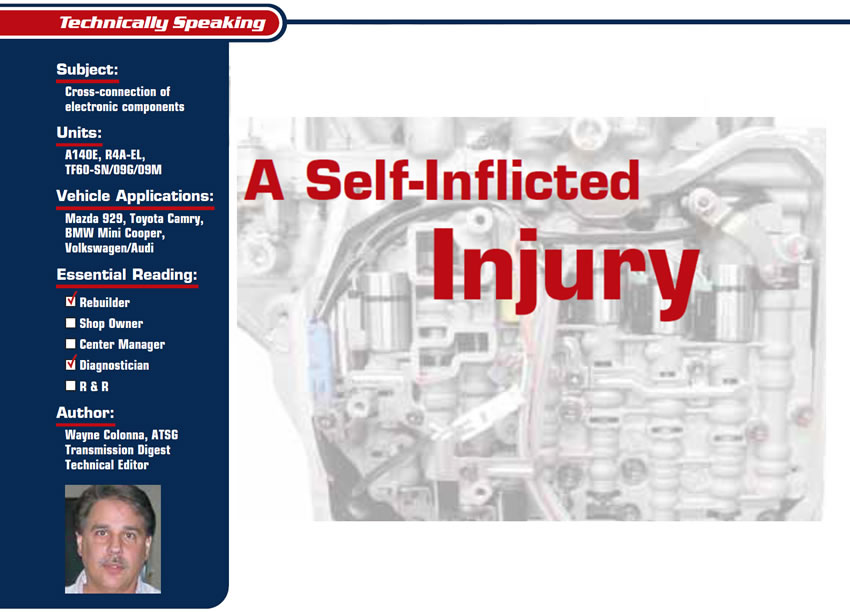
Technically Speaking
- Subject: Cross-connection of electronic components
- Units: A140E, R4A-EL, TF60-SN/09G/09M
- Vehicle Applications: Mazda 929, Toyota Camry, BMW Mini Cooper, Volkswagen/Audi
- Essential Reading: Rebuilder, Diagnostician
- Author: Wayne Colonna, ATSG Transmission Digest Technical Editor
There is nothing worse than building a great transmission that goes wrong because of a wiring cross-connection of solenoids and the like. It’s interesting that as often as this error occurs, it still seems to elude the technician as being one of the possibilities in the diagnostic process. This cross-connection possibility needs to be in the diagnostic approach, especially when you’re dealing with a problem the vehicle didn’t have before repairs or with a vehicle that came to you from another shop with a problem or that was purchased from an auction recently.
There have been enough different cross-connection scenarios that ATSG could easily do a full-day seminar on the subject. The worst of all involved an R4A-EL transmission in a Mazda 929 on which the input-speed sensor was cross-connected with the heated O2 sensor. Soon after the vehicle was started, voltage from the ECM that was supposed to be going to the heated O2 sensor was being routed to the TCM because of the cross-connection error.
As the technician was filling the transmission with fluid, a great deal of smoke started billowing out from under the dash. After the panic of shutting down the vehicle subsided and the smoke cleared, there was a bit of head scratching going on (and screaming by the boss – go figure) before the error was finally discovered. After $3,000 in parts alone, the car was finally delivered. By the way, the transmission worked well.
Another incident that really floored me took place with a Toyota A140E transmission in a Camry. The tech call came in with the technician saying it had wrong-gear starts followed by erratic shifting. After a bit of discussion I realized that it had third-gear starts and shifted to second, then to fourth and into first. So I told him he had the two shift solenoids in the transmission cross-connected. Then the argument came that it was not possible to cross-connect the solenoids because one wire lead was shorter than the other, making it impossible to cross-connect them.
I then said he was right, but only if the wiring harness was routed past the valve body correctly. If the harness was positioned incorrectly during the installation of the valve body, the solenoid wiring would now allow for the cross-connection error. And this mistake occurred with such frequency that by the shift pattern I knew this had to be the problem. Of course, the technician I was talking with was convinced that he had routed the wires correctly and that I was wrong.
What we eventually discovered was that we were both right. Apparently this vehicle had been in for transmission repairs years before at a different facility, which had made this error of cross-connecting the solenoids and, rather than dropping the pan and rerouting the wiring harness to correct the error, went to the TCM and switched the solenoid wires in the connector. Now the vehicle came to this shop for repairs, and the technician who rebuilt the transmission assembled the valve body onto the transmission with the wiring routed correctly. So we were both right, but yet this lesson just added another whole new dimension to diagnosing cross-connection scenarios.
Recently, I was at a seminar where I ran into a great guy I know, Eric Dibner from Euro Auto in Connecticut. He was wearing a shirt that had written on the back of it, “If you think this Automotive Technician is expensive … try a bad one.” What a great line, and how true it is. So if you hear a technician say, “If you cannot fix it with a hammer, it must be an electrical problem,” watch out; you’re in for some fun.
In closing, I’ll share yet another cross-connection scenario that easily could happen to even the best of rebuilders. It has to do with the TF60-SN (BMW Mini Cooper) or the 09G/09M (Volkswagen/Audi) transmission. This valve body sports a full rack of solenoids, as you can see in Figure 1.

At the bottom-left corner are two solenoids side by side designated N88 and N89. Their functions as described by Volkswagen follow.
- N88 (#1 solenoid)
- N88 is an on/off solenoid and is on and open in gears 4th through 6th. If this solenoid fails closed (in the off state), 4th through 6th will not be available.
- N89 (#2 solenoid)
- N89 is also an on/off solenoid and is on and open to apply the converter clutch. When the N88 and N89 solenoids are energized at the same time, the B2-brake clutch is applied in Tiptronic 1st gear (manual low). If the N89 solenoid fails in the closed (off) state there will be no converter-clutch apply and no engine braking in Tiptronic 1st gear (manual low).
Should the N88 and N89 solenoids be accidentally cross-connected, there will be a complaint of no 4th, 5th or 6th gear.
A closer look at these two solenoids (Figure 2) shows that the white wire connector is attached to solenoid N88 and the black wire connector is to be attached to N89.

At least this solenoid cross-connection will cause smoke to come out of only the shop owner’s ears and not the harness.














